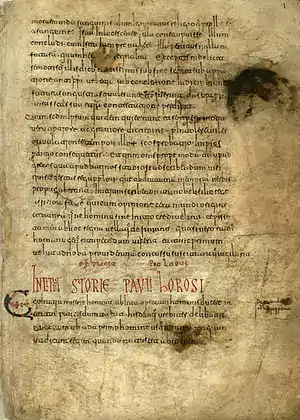Códice de Roda
The Códice de Roda or Códice de Meyá (Roda or Meyá codex) is a medieval manuscript that represents a unique source for details of the 9th and early 10th century Kingdom of Navarre and neighbouring principalities. It is currently held in Madrid as Real Academia de la Historia cód. 78.[1]

The codex is thought to date from the late 10th century, although there are additions from the 11th century, and it was compiled in Navarre, perhaps at Nájera, written in a visigothic minuscule in several different hands with cursive marginal notes. It is 205 mm × 285 mm (8.1 in × 11.2 in), and contains 232 folios.[1] The manuscript appears to have been housed at Nájera in the 12th century, and later in the archives of the cathedral at Roda de Isábena at the end of the 17th century. In the next century, it was acquired by the prior of Santa María de Meyá, passing into private hands, after which only copies and derivative manuscripts were available to the scholarly community until the rediscovery of the original manuscript in 1928.[2]
The codex includes copies of well-known ancient and medieval texts, as well as unique material. The first two-thirds of the compilation reproduces a single work, Paulus Orosius' Historiarum adversum paganos libri VII. Also notable are Isidore of Seville's History of the Vandals and Suebi and History of the Goths, the Chronica prophetica (a chronicle related to the Chronicon Albeldense),[3] and a genealogy of Jesus. Unique items include a lists of Arab rulers and of the Christian kings of Asturias-León, Navarre and France, a chronicle of the Kingdom of Navarre, the Chronicle of Alfonso III, a necrology of the Bishops of Pamplona and the De laude Pampilone epistola. It also includes a chant in honour of an otherwise unknown Leodegundia Ordóñez, Queen of Navarre.[1][2] Still, the manuscript is perhaps best known for its genealogies of the dynasties ruling on both sides of the Pyrenees.[2][4]
The genealogies in the Roda Codex have played a critical role in interpreting the scant surviving historical record of the dynasties covered. The family accounts span as many as five generations, ending in the first half of the 10th century. These include the Íñiguez and Jiménez rulers of Pamplona, the counties of Aragon, Sobrarbe, Ribagorza, Pallars, Toulouse and the duchy of Gascony. It has recently been suggested that these genealogies, reminiscent of the work of Ibn Hazm, were prepared in an Iberian Muslim context in the Ebro valley and passed to Navarre at the time the codex was compiled.[2][4]
References
- Citations
- García Villada
- Lacarra (1945)
- John Wreglesworth (2010). "Crónica profetica". In Graeme Dunphy (ed.). Encyclopedia of the Medieval Chronicle. Leiden: Brill. p. 400. ISBN 90 04 18464 3.
- Lacarra (1992)
- Bibliography
- Zacarías García Villada, "El códice de Roda recuperado," Revista de Filología Española 15:113-130 (1928).
- José María Lacarra. "Textos navarros del Códice de Roda," Estudios de Edad Media de la Corona de Aragón, 1:194-283 (1945).article without accompanying genealogical charts
- José María Lacarra. "Las Genealogías del Códice de Roda," Medievalia, 10:213-6 (1992).